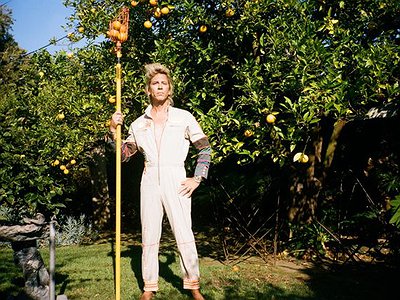When did you start composing - and what or who were your early passions and influences?
I began composing in 1976 but it wasn’t until 1978 that I began to find a wormhole into what eventually became my musical universe. Learning how to listen, learning about John Cage’s chance processes and the freedom he gave himself were essential. Hearing Steve Reich’s early tape experiments with loops and delay and his translations into orchestration later with Music for 18 Musicians were big ear openers, and the haunting melancholy of Brian Eno’s Music for Airports gave me license to explore and purge my own feelings of loss and longing.
What do you personally consider to be incisive moments in your work and/or career?
Meeting my partner of 30+ years, James Elaine … a great artist, music fanatic and collector who encouraged me at the very beginning, and never stopped opening my heart, ears and eyes. James has been curating contemporary art for the last 20 years focusing on emerging artists. He has discovered and nurtured many great artists who have gone on to make great work and careers in the international art world. I am his first child. He’s a spectacular human being. Of course, the period from 1978 to 1984 was a very prolific period for me developing my sound, exploring the universe with my cheap spaceship made of rust and cellotape.
There was no context then, no rules … so I made them up as I went along with a bit of formal training and open ears. As far as the career goes, meeting Carsten Nicolai in NY in 1995 and having him ask to release Shortwavemusic was a delight, and a long time coming. Then, when The Disintegration Loops collapsed into my studio in 2001 just at the moment when I felt I had lived too long and no one was ever going to understand what I was trying to do, the universe opened the slipstream and my “career” was launched.
What are currently your main compositional challenges?
I’m working on a video for Nocturnes, the new release coming out very soon, as well as a Requiem for Water with LA artist Lauren Bon who is documenting the effects on the Owens Valley and particularly the dry Owens Lake near Mount Whitney as a result of Mulholland’s scheme which diverted the fresh water to Los Angeles 100 years ago this November.
What do you usually start with when composing?
What to do ... what to do … what to do? It depends … usually it’s very intuitive and some gnat flies into my ear.
How do you see the relationship between timbre and composition?
As my work is very textural as opposed to traditionally percussive, timbre is highly influential. The right one can set me off on a trajectory.
What do improvisation and composition mean to you and what, to you, are their respective merits?
They are the same thing. Improvisation is simply an immediate, stream of consciousness form of composition but one can’t erase mistakes, one has to make them work after the fact, so that can be kind of interesting, or not …
Do you feel it important that an audience is able to deduct the processes and ideas behind a work purely on the basis of the music? If so, how do you make them transparent?
No, the music should stand on it’s own. Processes and ideas are for liner notes or further inquiry if there is interest.
The relationship between music and other forms of art – painting, video art and cinema most importantly - has become increasingly important. How do you see this relationship yourself and in how far, do you feel, does music relate to other senses than hearing alone?
Music is mystical. It gives us pictures, emotions, it goes directly into our brain, our tissue, our bones, our memory. It can break our heart or bring tears of joy.
How would you define the term “interpretation”? How important is it for you to closely work together with the artists performing your work?
I love working with musicians. As a musician myself, I have great respect for the dedication to their craft and musicianship. Interpretation is all important, from what is on the page, to how that is developed by the conductor, and how each of the individuals puts his heart into the instructions given by those directions.
I’ve had the great joy in the past couple of years to work with the brilliant Maxim Moston, who arranged the first two Disintegration Loops for orchestra and the talented young maestro, Ryan McAdams, who has conducted the two presentations we have made so far. Both of them were given very much free range to do what they do very well, and seeing them bring the works to life with the very talented young musicians in NY and London was just the most extraordinary experience. Some more orchestral concerts are planned for fall in Europe: Geneva on September 1st and Denmark, November 15th.



